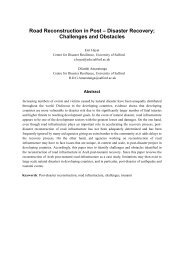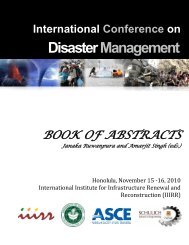Alternative resilient livelihood option for fisher-folks tsunami victims
Alternative resilient livelihood option for fisher-folks tsunami victims
Alternative resilient livelihood option for fisher-folks tsunami victims
You also want an ePaper? Increase the reach of your titles
YUMPU automatically turns print PDFs into web optimized ePapers that Google loves.
cycles in a year the estimated annual income will be Rs.63880.00. This ultimately depends on the<br />
ef<strong>for</strong>t taken by the individual and the prevailing ecological conditions of the region.<br />
Table 4: Economic analysis <strong>for</strong> the operation of 5 cages in the first fattening cycle<br />
Particulars Quantity Rate(Rs) Total(Rs)<br />
Expenditures<br />
Wooden cages 5 Nos 2650.00 13,250.00<br />
Cost of Watery crabs 30 kg 600.00 18,000.00<br />
Feed cost 4410.00<br />
Cage repair and maintenance cost 700.00<br />
Harvesting charges 1000.00<br />
Total 37,360.00<br />
Income<br />
Crab sales-1 38kg Rs.1500.00/kg 57,000.00<br />
Crab sales-2 8.2kg Rs.1500.00/kg 12,300.00<br />
Total 69,300.00<br />
Profit( 5 cages) 31,940.00<br />
Profit (1 cage) 6,388.00<br />
In cage, the activities of fish is restricted, there<strong>for</strong>e the energy loss was low hence the chance of<br />
increasing the weight of the fish compared to wild was more, However, cage culture site water<br />
quality more or less same <strong>for</strong> the optimal growth of milk fish. In this experiment, average weight of<br />
a harvested fish during farming cycle was 558.5 gm. Initially growth and standard length increment<br />
were meager because of the salinity variation in our pond. Initially up to the February salinity varies<br />
between the 0 ppt to 5 ppt because of heavy shower. However from the March to May salinity<br />
varies between 5 ppt to 15ppt (Table 5). Milk fish is euryhaline fish (Ramanatha and Jaysmaha,<br />
1970) shows optimal growth at higher salinity there<strong>for</strong>e growth and standard length increment were<br />
lower in first 3 months here after weight gain and length were suddenly increasing. In our<br />
experiment, the mean survival percentage was 93.33% and mean mortality was 6.67%. The<br />
mortality was at an acceptable level and it was experienced at the initial stages of the farming.<br />
These initial mortalities occurred during first three months could be due to highly stressed, new<br />
environment, salinity changes and poor handling during transport and stocking. It is there<strong>for</strong>e felt<br />
that the survival rate can be improved considerably through better handling, transporting and<br />
stocking.

















